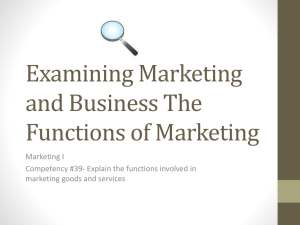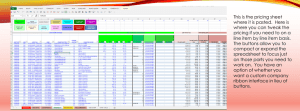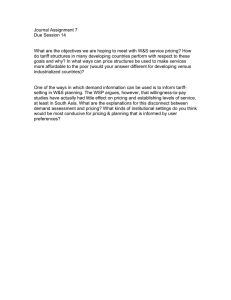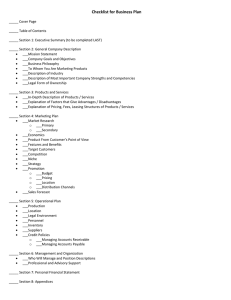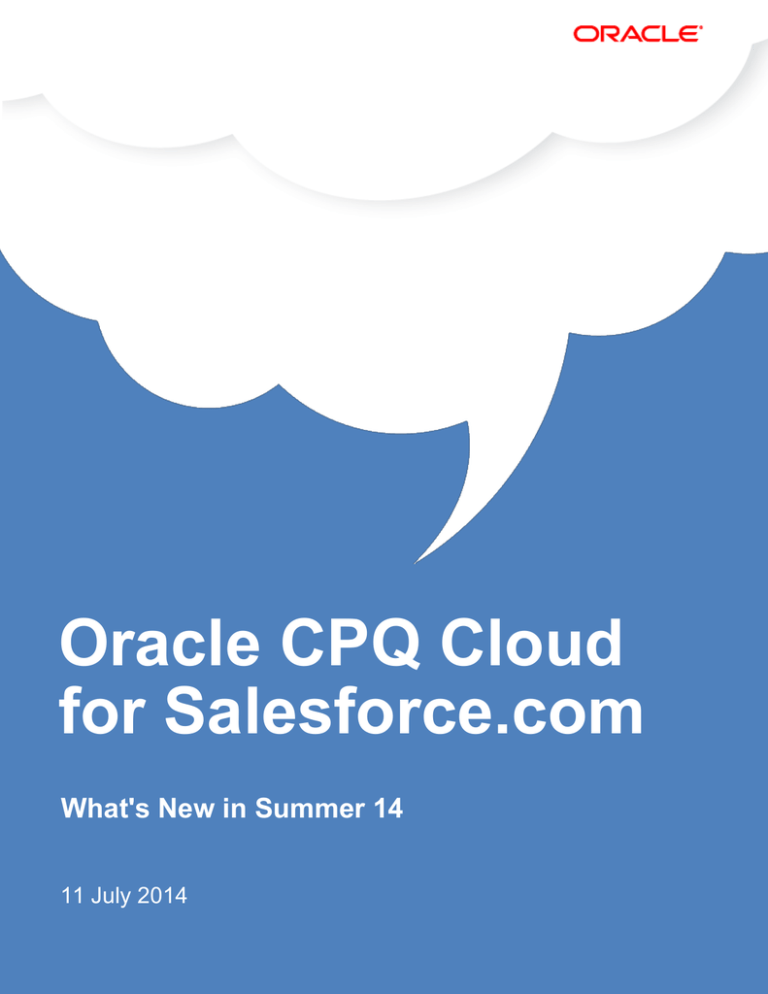
Oracle CPQ Cloud
for Salesforce.com
What's New in Summer 14
11 July 2014
TABLE OF CONTENTS
TABLE OF CONTENTS ..............................................................................................................................................2
OVERVIEW .............................................................................................................................................................3
RELEASE FEATURE SUMMARY ................................................................................................................................4
UPDATING PERMISSION SETS ................................................................................................................................5
STEP BY STEP INSTRUCTIONS ............................................................................................................................................ 5
NEW METADATA.................................................................................................................................................. 11
CONFIGURATION ......................................................................................................................................................... 11
PRICING ..................................................................................................................................................................... 11
QUOTING................................................................................................................................................................... 13
RENEWALS ................................................................................................................................................................. 13
CONFIGURATION ................................................................................................................................................. 14
EASIER ADMINISTRATION .............................................................................................................................................. 14
INLINE QUANTITIES & DISCOUNTS .................................................................................................................................. 16
BUNDLING ENHANCEMENTS .......................................................................................................................................... 18
PRICING ............................................................................................................................................................... 19
CUSTOM PRICING RULES ............................................................................................................................................... 19
MASS CREATE PRICING RULES........................................................................................................................................ 21
QUOTING ............................................................................................................................................................. 24
CUSTOM COLORS ........................................................................................................................................................ 24
RELATED LISTS ............................................................................................................................................................ 25
ADDITIONAL INFORMATION ................................................................................................................................ 27
BROWSER SUPPORT ..................................................................................................................................................... 27
DISCLAIMER ............................................................................................................................................................... 27
REVISION HISTORY ............................................................................................................................................... 27
2
OVERVIEW
This guide outlines the information you need to know about new or improved functionality in the
Summer 14 update for Oracle CPQ Cloud for Salesforce.com, formerly BigMachines Express. Each
section includes a brief description of the feature, the steps you need to take to enable or begin using
the feature, any tips or considerations that you should keep in mind, and the resources available to help
you.
IMPORTANT NOTE
This update introduces new metadata including custom objects, custom fields, classes and pages.
Immediately following the update administrators must update all custom permission sets for users and
admins to include access to this new metadata. Failure to do so can restrict your users’ ability to quote.
All Quoting customers, all Renewals customers and Configuration or Pricing customers using custom
permission sets must follow the steps detailed under Updating Permission SetsUpdating Permission Sets
beginning on page 5 in order to ensure users have uninterrupted access to BigMachines Express.
3
RELEASE FEATURE SUMMARY
Some of the new Summer 14 features are automatically visible to users after the update and some
require action from company administrator to enable. The table below offers a brief summary of the
new Summer 14 features and a quick view of the actions required to enable them.
Action Required to Enable Feature
Features
Automatically
Available
Administrator
Action Required
Configuration
Easier Administration
Enhancements which make creating and maintaining blueprints
faster and easier
Inline Quantities & Discounts
Allows sales reps to adjust quantities and enter discounts while
configuring products
Bundling Enhancements
Bundles can contain up to 25 features and are available on
dynamic product rules
Pricing
Custom Pricing Rules
Rules can be created which discount products when businessspecific criteria are met
Mass Create Pricing Rules
Create large numbers of custom pricing rules by copying and
pasting a table from a spreadsheet into the browser
Quoting
Custom Colors
Choose colors for a proposal template using a hex code
Related Lists
Print a table on the proposal which lists the records in any related
list available on a quote
4
UPDATING PERMISSION SETS
After updating BigMachines Express administrators must take the following steps to add the new
metadata to any custom permission sets. This will enable access to all the necessary end user pages,
setup pages and settings and prevent error messages for end users. These steps are required for both
manual upgrades and automatic push upgrades.
NOTE: These steps are not required for the permission sets packaged with the Basic, Configuration and
Pricing modules. These permission sets will be automatically updated. Packaged permission sets are
identified by having a namespace prefix of BMXB, QConfig or BMXP.
STEP BY STEP INSTRUCTIONS
These step-by-step instructions are general instructions and the images may not directly correlate to the
permissions which need to be added with this update. For that detail please reference the New
Metadata section below.
STEP 1:
Navigate in Salesforce to: Username > Setup > Manage Users > Permission Sets
NOTE: Depending on your Salesforce UI settings the Setup link may be under the user name drop down
menu or to the right of your username.
STEP 2:
Select a permission set to edit. This will need to be done for all custom permission sets. Each permission
set is specific to one module.
5
STEP 3:
On the Permission Set Overview page, you will need to edit the following settings: Object Settings, Apex
Class Access and Visualforce Page Access.
Select Object Settings.
6
STEP 4:
Select the BigMachines Express Object that you need to grant access to.
See the New Metadata section below for a complete list of objects which must be updated.
7
STEP 5:
On each object you must update the Object Permissions and/or the Field Permissions. Click Edit. For
new Objects assign the appropriate Object Permissions (CREDVM) and Field Permissions (Read, Edit) for
each user type. For new Fields assign the appropriate Field Permissions (Read, Edit) for each user type,
object permissions for existing objects do not need to be changed.
See the New Metadata section below for specific detail on which permissions are required for each user
type.
Save the changes.
Repeat Steps 4 and 5 for each new object and field.
8
STEP 6:
Return to the Permission Set overview page (see Step 3). Select Apex Class Access. Click Edit.
Select the Apex classes which belong to the module associated with this permission set. Enable the
selected Apex classes by clicking Add and Save. In most cases, each permission set will contain all the
Apex classes that begin with that module’s namespace.
See the New Metadata section below for specific detail on which Apex classes are new for each module.
9
STEP 7:
Return to the Permission Set overview page (see Step 3). Select Visualforce Page Access. Click Edit.
Select the Visualforce pages which belong to the module associated with this permission set. Enable the
selected Visualforce pages by clicking Add and Save.
See the New Metadata section below for specific detail on which Visualforce pages are new for each
module and which user type should have them enabled.
Return to Step 2 and repeat for each custom permission set.
10
NEW METADATA
These tables outline the access and permissions required for each module, user type and component.
CONFIGURATION
The following metadata is new in the Summer 14 update of the Configuration module.
FIELDS
Object
Field
Product Rule Quantity Default
Quantity_Picklist
Quantity_Type
Quantity Default
Quantity_Picklist
Quantity_Type
User Type
Admin
Admin
Admin
Sales User
Sales User
Sales User
Read
✔
✔
✔
✔
✔
✔
Edit
✔
✔
✔
PRICING
The following metadata is new in the Summer 14 update of the Pricing module.
OBJECTS
Object
Pricing Rule Definition
Pricing Rule Detail
Rule Definition Meta
Pricing Rule Definition
Pricing Rule Detail
Rule Definition Meta
User Type
Admin
Admin
Admin
Sales User
Sales User
Sales User
CREDVM
CRED
CRED
CRED
R
R
R
11
FIELDS
Object
Field
Pricing Rule
Pricing Rule Definition
Pricing Rule Definition Description
Unique Name
Pricing Rule Detail
Pricing Rule
Rule Definition Meta
Value
Rule Definition Meta
API Mergefield
API Object
Index
Operator
Pricing Rule Definition
Pricing Rule
Pricing Rule Definition
Pricing Rule Definition Description
Unique Name
Pricing Rule Detail
Pricing Rule
Rule Definition Meta
Value
Rule Definition Meta
API Mergefield
API Object
Index
Operator
Pricing Rule Definition
User Type
Admin
Admin
Admin
Admin
Admin
Admin
Admin
Admin
Admin
Admin
Admin
Sales User
Sales User
Sales User
Sales User
Sales User
Sales User
Sales User
Sales User
Sales User
Sales User
Sales User
REad
✔
✔
✔
✔
✔
✔
✔
✔
✔
✔
✔
✔
✔
✔
✔
✔
✔
✔
✔
✔
✔
✔
Edit
✔
✔
✔
✔
✔
✔
✔
✔
✔
✔
✔
CLASSES
Class
BMXP.CustomTypePricingPlugin
BMXP.DefineRuleTypeCtrl
BMXP.CustomTypePricingPlugin
BMXP.DefineRuleTypeCtrl
BMXP.PricingMassAdminCtrl
BMXP.PricingNavCtrl
BMXP.TestDefineRuleTypeCtrl
BMXP.ValidationUtils
BMXP.testCustomPricingRules
User Type
Admin, Sales User
Admin, Sales User
Admin, Sales User
Admin, Sales User
Admin, Sales User
Admin, Sales User
Admin, Sales User
Admin, Sales User
Admin, Sales User
PAGES
Page
User Type
BMXP.DefineRuleType
Admin
BMXP.PricingMassAdmin Admin
12
QUOTING
The following metadata is new in the Summer 14 update of the Quoting module.
FIELDS
Object
Field
Proposal Template Color
Color
User Type
Admin
Sales User
REad
✔
✔
Edit
✔
CLASSES
Class
User Type
BMXQ.ColorUtil Admin, Sales User
PAGES
Page
User Type
BMXQ.Quote_Related_List
Admin
BMXQ. Quote_Related_List_DOC Admin
RENEWALS
The following metadata is new in the Summer 14 update of the Renewals module.
CLASSES
Class
User Type
BMXR. renewalsAssetTriggerHandler Admin, Sales User
BMXR. renewalsOpptyTriggerHandler Admin, Sales User
13
CONFIGURATION
EASIER ADMINISTRATION
Enhancements to the configuration blueprint setup pages make it faster and easier for administrators to
create, edit and maintain configuration blueprints. New features include:
Save and Clone Fields: quickly make copies of configuration fields
Save and Clone Configuration Rules: quickly make copies of configuration rules including their
conditions and actions
Search Blueprints: keyword search within a blueprint to quickly locate fields and rules
Improved Pagination: jump to any page of fields or rules within a blueprint
Quick Links in Error Messages: field delete error messages contain quick links to rules blocking
deletion
SETUP & USE
Save and Clone Fields
Administrators can now quickly duplicate fields using the new Save & Clone button on the field Edit
page. This allows users to create sets of similar fields and replace existing fields with fewer clicks.
Cloned fields have the word Copy appended to the original
field’s label and name.
NOTE: Cloned fields are not automatically saved, you must
save the new field before continuing.
Save and Clone Configuration Rules
Administrators can now also quickly duplicate configuration rules using the new Save & Clone button on
the configuration rule edit page. This allows users to quickly copy rules along with their conditions and
actions. This is particularly useful when creating mutually exclusive rules.
14
Cloned rules have the word Copy appended to the
original rule’s name.
NOTE: Cloned rules are not automatically saved,
you must save the new rule before continuing.
Search Blueprints
Administrators can now quickly locate fields, configuration rules and product rules within a
configuration blueprint. This search box is located on the configuration blueprint detail page and helps
users more easily manage complex blueprints with large numbers of fields and rules.
The blueprint filter will filter on field label, configuration rule name, product and product rule name. The
filter does not filter against conditions, actions or operators. Clicking the Clear button clears the filter
and returns all items in the blueprint.
15
Improved Pagination
Administrators can now quickly jump to any page in the
list of fields, configuration rules or product rules on the
configuration blueprint detail page. This makes it easier
for users to navigate to items in large blueprints.
Quick Links in Error Messages
Administrators can now jump to configuration rules and product rules via quick links in the field delete
error message displayed on the configuration blueprint detail page. Clicking on the quick link opens the
rule blocking the deletion of a field in a new tab allowing the user to edit the rule and resolve the error
more quickly.
INLINE QUANTITIES & DISCOUNTS
Sales reps can now edit the quantity of individual line items and enter discounts while configuring
products. This reduces clicks and makes quoting more intuitive for end users by consolidating this
functionality into a single user interface. It also simplifies blueprints by eliminating the need for
additional fields to capture simple product quantity inputs. This functionality can be selectively enabled
by the administrator. New features include:
Inline Quantities: sales reps can enter or change the quantity value of line item using a
number or a pick list
Inline Discounts: sales reps can enter a discretionary discount on line items using a percentage
SETUP & USE
Inline Quantities
Sales reps can now change the quantity of line items directly in the configurator using a value or a pick
list of numbers. An input field appears in the line item grid in place of the quantity value when enabled
by the administrator.
16
Administrators can enable this functionality on individual product rules. This gives administrators the
ability to control which line item quantities can be changed and use rule conditions to only allow
changes when specific business rules are met.
Administrators activate this feature by
modifying the new quantity type field on the
product rule edit page.
Value: Static number set by the admin
Field: Static value set to the value of a
number field
Editable Value: User editable number with a
default set by the admin
Editable Picklist: User editable numeric
picklist with a default set by the admin
NOTE: By default all product rules remain not editable after update. Bundled features cannot have
editable quantity values.
Inline Discounts
Sales reps can now add a percent discount to line items directly in the configurator. An input field
appears in the line item grid in new discount column when enabled by the administrator. This reduces
clicks for the sales rep by reducing reliance on the standard Salesforce Edit Line Items page.
Administrators can enable this feature on the Edit Layout page.
17
Located below the tabs and sections grid on the
Edit Layout page a new section for adding
additional columns to the line item grid is
available. Checking the Discount column
enables the discount column for all line items in
the configurator.
NOTE: By default the discount column is unchecked and inline discounts are not available to sales reps
after update. Bundled features cannot have additional discounts.
BUNDLING ENHANCEMENTS
Bundling functionality has been expanded to allow for bundles with more conditional features (25) to
support more complex systems or more variable scenarios. Features and pricing formulas are now also
available for use with dynamic product rules. New features include:
25 Features per Product Rule: product rules can have up to 25 features with conditions
Features on Dynamic Product Rules: products added using dynamic product rules can now
have features
Price Formulas on Dynamic Product Rules: administrators can now define the price of a
dynamic product using a formula
SETUP & USE
25 Features per Product Rule
Administrators can now have up to 25 features on a product rule. This enhancement is immediately
available on update and requires no action.
Features on Dynamic Product Rules
Administrators can now include features on dynamic product rules. This allows administrators to
dynamically add bundles to configurations when the bundle’s parent product’s name matches a formula
defined by the administrator. This enhancement is immediately available on update and requires no
action.
Price Formulas on Dynamic Product Rules
Administrators can now set the price of a dynamic product using a price formula. This enhancement is
immediately available on update and requires no action.
NOTE: Bundling, Dynamic Product Rules and Price Formulas were introduced in the Spring 14 update.
For more information on their use please reference the Spring 14 release notes or the knowledge
articles in My Oracle Support.
18
PRICING
CUSTOM PRICING RULES
Administrators can define new pricing rule types using their own criteria. These conditions can refer to
standard or custom fields on the opportunity, quote, product, account or user. Customers can now
create unique pricing rules which are tailored to their sales strategy. Examples include, but aren’t limited
to:
Regional Pricing: discount specific products or product groups on quotes to accounts in a
specific country, state or geographic region
Promotional Pricing: discount specific products or product groups on quotes issued between a
given time frame
Partner Pricing: discount specific products or product groups on quotes that are created by
specific partner users or for partner account types
Tiered Account Pricing: create simple layered pricing scenarios where certain account types
(strategic, government) use a different volume discounting structure than other account types
(commercial, general).
SETUP & USE
Custom Pricing Rules
Administrators can now define new pricing rule types using a table-based system in which each column
correlates to a Salesforce field and the value of that field is a condition which must be met in order for
the pricing rule to execute.
Administrators begin by clicking Define New Rule Type on the pricing rules setup page.
Each rule type is given a label and a unique
name. The rule label will be displayed as the
price source to sales reps on the configuration
page and as a field on the quote line item.
Custom pricing rules types are then given up to 5 conditions.
19
Each pricing rule condition will contain a Salesforce object, a field on the selected object and an
operator.
The Salesforce objects available for use in custom pricing rules are:
Account
Contact
Product
Opportunity
Quote
Quote Line Item
User
Once a new custom pricing rule type has been
created it will appear as a selection in the pricing rule
navigation menu.
Selecting your new rule and clicking Go will allow you
to add pricing rules to your new custom pricing rule
type.
When creating a new pricing rule, the
user will choose values for each condition,
which will cause the rule to be triggered.
The user will also set the discount and
discount type to apply.
20
In this example pricing rule, any account in Illinois that is part of a “New Business” opportunity type
containing a product in the “Software” product family will receive a 25% discount.
NOTE: Once a pricing rule type has been created and rules have been saved for it, the conditions can
only be changed by deleting all of the conditions or creating a new rule type.
MASS CREATE PRICING RULES
Create large numbers of custom pricing rules by copying and pasting a table from any spreadsheet or
database software into the custom pricing rule setup page within the browser. By preparing pricing rule
tables offline using traditional office applications like Microsoft Excel or Google Spreadsheets,
administrators and product managers can create large amounts of data programmatically, collaborate,
and/or leverage existing data to build new pricing rules in the Pricing module.
SETUP & USE
Mass Create Pricing Rules
Administrators can now create large numbers of custom pricing rules in bulk by copying a table from a
spreadsheet and pasting it into the new Mass Create page. Once a user has created a new custom
pricing rule type, a Mass Create button is available on the pricing rule type page.
21
On the mass create page the user is given a blank table.
Using spreadsheet software like Microsoft Excel, the administrator or other stakeholders can prepare a
table of pricing rules, highlight up to 800 rows and paste them into the web browser.
22
NOTE: Once you have mass created and saved pricing rules, there are two ways to edit or delete them:
1. Edit or delete each pricing rule individually
2. Delete the custom pricing rule type, recreate that pricing rule type, and then mass create a new set
of pricing rules
As such, care should be taken to validate spreadsheet data prior to loading it to prevent administrators
from having to repeat work.
23
QUOTING
CUSTOM COLORS
Administrators can choose a custom color for the provided style templates in the Quoting module.
Customers can now select the proposal style they’d like and match it to corporate branding using a color
hex code.
SETUP & USE
Custom Colors
Administrators can now define the color used by each of the provided style templates by entering a 6
character color hex code. This setting is available on the layout tab of the proposal template page.
Users can select from any of the style templates
provided and enter the desired color code. The
hex code for the new color will replace the
primary color of the provided style. A secondary
color for the template will be inferred from the
primary color.
NOTE: The hex code must be preceded by the #
symbol as shown. The Standard style contains
color and the hex code entered will have no
effect.
24
RELATED LISTS
Proposals can now contain additional related lists other than line items. Additional related lists can be
used to detail for the buyer renewed assets, contacts, partners or other miscellaneous information
stored on the quote that may be relevant.
SETUP & USE
Related Lists
Administrators can now add additional sections to proposal templates which include many standard and
custom related lists on the quote object. Each related list can be customized to include up to 8 columns
and given a custom section header name.
The available related lists on the quote will be shown in the proposal section selector on the layout tab.
Each included related list will appear on the proposal as a new section if it has records. All related lists
will use the same style as the line item grid for the chosen style template.
A new tab is available on the proposal template page for related lists.
25
On the related lists tab users will define how each available related list will be displayed when included
on a proposal.
Each related list can be given a section label which will display as the heading
All fields on the related object are shown as available fields and up to 8 can be selected and
ordered
The records of the related list can be sorted by any available field
26
ADDITIONAL INFORMATION
BROWSER SUPPORT
In most cases, when using standard functionality, BigMachines Express Summer 14 is compatible with all
browsers supported by Salesforce. For more information, see this article.
The new Mass Create page relies on modern web technologies including HTML5 and CSS3 and as such,
requires modern browsers that support those web technologies.
Mass Create supported browsers:
IE9+, Chrome 31+, Firefox 26+, Safari 7
Word Output is supported on the latest two releases of Microsoft Word for Windows only.
Word Output supported versions:
Microsoft Word 2010 for Windows, Microsoft Word 2013 for Windows
DISCLAIMER
These Release Notes are provided for high-level informational purposes only and are not intended to
function as a specification or to replace the Product Help and/or User Guide.
REVISION HISTORY
This document will continue to evolve as existing sections change and new information is added. All
updates are logged below, with the most recent updates at the top.
Date
August 8th, 2014
What’s Changed
Added Updating Permission Sets
and New Metadata Sections
Notes
These changes outline important required steps for
administrators following update.
IMPORTANT: Please note it is possible that not every change has been covered in this document. The
Revision History section, found above, will be utilized to rectify and recognize these instances. Please
refer to the Product Help available in My Oracle Support for the most up-to-date documentation,
detailed instructions, and use cases.
27
Copyright © 2014, Oracle and/or its affiliates. All rights reserved.
This document is provided for information purposes only, and the contents hereof are subject to change without notice.
This document is not warranted to be error-free, nor subject to any other warranties or conditions, whether expressed
orally or implied in law, including implied warranties and conditions of merchantability or fitness for a particular purpose.
We specifically disclaim any liability with respect to this document, and no contractual obligations are formed either directly
or indirectly by this document. This document may not be reproduced or transmitted in any form or by any means,
electronic or mechanical, for any purpose, without our prior written permission.
Oracle and Java are registered trademarks of Oracle and/or its affiliates. Other names may be trademarks of their
respective owners.
Intel and Intel Xeon are trademarks or registered trademarks of Intel Corporation. All SPARC trademarks are used under
license and are trademarks or registered trademarks of SPARC International, Inc. AMD, Opteron, the AMD logo, and the
AMD Opteron logo are trademarks or registered trademarks of Advanced Micro Devices. UNIX is a registered trademark
of The Open Group. 0114


